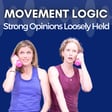
21: Is the SI Joint Painful Due to Instability?
Welcome to Episode 21 of the Movement Logic podcast! In this solo episode, Laurel shares her history with sacroiliac joint (SIJ) pain, and how no less than shifting her identity as a teacher, the way she thought of her SIJ, and the way she moved her body on a regular basis is what was required of her to get herself out of pain.
The SIJ is an area of the body that is surrounded by misinformation and tainted by a rather pessimistic outlook on its stability and robustness.
These fragilizing, pessimistic attitudes often result in triggering language around the SIJ that can lead people in pain to believe that their SIJ is unstable, out of place, or moving in the wrong ways.
This episode combines some anatomy and biomechanics along with plenty of human psychology and even human evolution to examine the power that words have over shaping our beliefs and identity, and how our beliefs and identity, in turn shape the language we use.
Laurel invites teachers to examine their beliefs about the body and question the words they use as thoughtfully as they choose their sequences, exercises, props, cues, and alignments. Additionally Laurel examines:
- Prevailing myths around the SIJ in both the movement and PT world.
- The problem with ideas around right and wrong alignment or good and bad exercises with regards to SIJ pain.
- A walk down memory lane to remember all the poses, alignments, and whole approaches to practicing the asanas that we demonized and blamed for our SIJ pain.
- Four reasons the SIJ is inherently stable, robust, and awesome.
- What pain science can teach us about SIJ pain and more and less effective ways of addressing it.
- What human evolution suggests about the SIJ and its stability.
- Why looking for a specific faultily-functioning mechanism to “fix” the SIJ is often less helpful than casting a wide net and making the body, or a general region of the body, more tolerant to loads.
- The scope of practice of a movement teacher when helping their students with painful SIJs feel better.
Reference links:
Sign up for a FREE mini course about the Hip and SIJ from Movement Logic co-creators Laurel Beversdorf, Dr. Sarah Court DPT, and Jesal Parikh.
Changing the Narrative in Diagnosis and Management of Pain in the Sacroiliac Joint Area
Born to Walk: Myofascial Efficiency and the Body in Movement
The Story of the Human Body: Evolution, Health, and Disease
Sign up here for the Movement Logic Newsletter for course discounts and sales and receive a free mini Pelvic Floor course!
Want more Movement Logic?
- Follow us on IG: @movementlogictutorials
- Get on our mailing list for tons of free content
- Contact us (we're super friendly)
Thanks for listening!


